HIKING HAPPENINGS January 2012
Poison Spider – What’s In A Name!
article and photos by Marcy Hafner
Have you ever wondered how the Poison Spider Trail received its name? The answer stems from the legend that a little girl named Mary Jane Francis died there from the bite of a poison spider in 1896! On a chilly clear wintry day - a season when few people are seen - I embark on a four mile walk to the Poison Spider Mesa to find her grave.
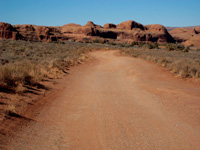
The legend of a spider bite is very intriguing. So are the dinosaur tracks that exist above this trail. Within this vicinity Therapods - such as Allosaurus, Eubrontes and Gallators - roamed across the largest dune field ever recognized on earth! As these giant reptiles - fast moving bipedal carnivores with short arms and claws to grasp their prey - made their passages over wet surfaces 190 million years ago, they left behind their fossilized imprints.
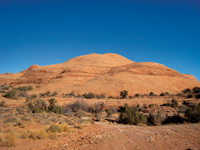
Several of the tracks can be viewed from the highway just below the trailhead, even without binoculars. Just look up to the first main bench to a tilted boulder with a smooth surface about the size of a car. For a closer look, a dirt trail from the vault toilet leads up to those tracks. In the cliffs above, there are at least ten more tracks of various meat-eating dinosaurs, which are preserved in blocks of Navajo Sandstone.
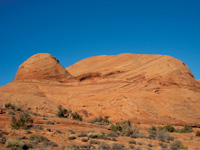
To get to the Poison Spider trailhead from Moab drive north on Highway 191. About 1.5 miles past the river turn left on Highway 279 (Potash Road) and drive 5.9 miles. Then turn right at the sign for a very short uphill drive to the parking area.
Spring through fall this multi-use trail is popular with mountain bikers and jeepers. For those with wheels, The Relaunch Pad, Waterfall, Wedgy and Tie-Rod Flats tell the story of tight switchbacks, high irregular ledges and steep slickrock - obstacles that are ripe for a lot of trouble. The painted white blocks on the blackened humps of Navajo Sandstone make this trail very easy to follow as it ascends approximately three miles to the mesa - a hard-core jeep trail that is far more challenging for the driver than the hiker! After the steep grind to the top, connections can be made with the Golden Spike, Gold Bar Rim and the Portal Trail along with a short spur to Little Arch, which overlooks the river.
At the beginning of my walk I am intermittently gazing down on the Colorado River in its prime. The heavy load of silt from spring run-off has settled out to reveal the lovely blue-green cloak that gleams with reddish reflections off the cliff walls towering above. Several switchbacks later I admire the swirling curvaceous formations of light brown Navajo Sandstone, which retain the graceful flow of the ancient sand dunes they used to be. As I progress around them the restful river setting below is gradually blocked out.
Every gain in elevation slowly opens the door for a tremendous change in scenery. Now miles beyond the river corridor, I am observing Behind The Rocks – a jumbled and bizarre geological demonstration of piercing upright domes and fins, which contrast dramatically with the sparkling silhouette of the La Sal Mountains. During my entire ascent to the top, this eye-catching view steadily pops in and out of sight.
After stumbling through an area of rubbly rocks that twist around under my feet, I am ready for a straight shot of level dirt that leads me to a lush, shadowy sand-based canyon where all the leafless oaks look starkly naked. In the summer this shaded refuge would be a blessed relief from the blazing heat. Today, however, I chase the sun and lingering here is like standing inside your freezer.
As I march upward on an extremely steep angled section of slickrock called “The Waterfall”, I marvel at where four-wheel drive vehicles can go! At the top, I learn the hard way to bear right, as going left quickly dead-ends. After all these exertions, I am rewarded with more in-depth views of the La Sals and Behind The Rocks.
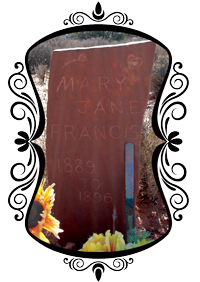
The last major obstacle for the four-wheelers is a V-shaped groove known as “The Wedgy”. After that it’s the final steep climb to plenty of sunshine on the mesa top where the “Whoop-Ti-Dos” await. One dip after another makes this section of road look like it has a bad case of the hiccups. Then, at a flattened stretch of dirt road referred to as the “High Speed Mesa”, the quietude of this off-season day sinks in as I survey the magnitude of a wide-open landscape soothingly extending out before me. 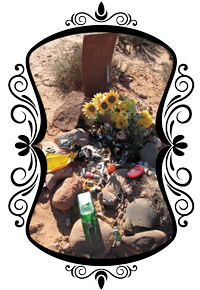
Along this portion of gently rolling ground, which supports a huge growth of blackbrush and stunted junipers, the artificial sunflowers finally draw me into the spot where Mary Jane Francis is buried. Her gravesite is lined with stones, and her name and the dates 1889 to 1896 are clearly carved on both headstones. This memorial has encouraged many to leave a parting tribute – a brake light, small teddy bear, toy rabbit, a grinch, magic markers, comb, a big set of dice, cards, tic tac mints, two fake birds, an empty bottle of jagermeister, necklaces and coins, especially quarters.
They have adorned her graveside with many remembrances for a tale that tells us so little. The questions are endless. Who was she? What did she look like? What games did she play? What was her personality like? Who were her parents? Where did they come from? What were they doing here? And most importantly – did she really die from the bite of a poison spider?
|
Biological Soil Crust (aka)
Cryptos (krip’ tose):
The surface of
Moab’s desert is held
together by a thin skin of living organisms known as cryptobiotic
soil or cryptos. It has a lumpy black appearance, is very
fragile, and takes decades to heal when it has been damaged.
This soil is a critical part of the survival of the desert.
The cryptobiotic organisms help to stabilize the soil, hold
moisture, and provide protection for germination of the seeds
of other plants. Without it the dry areas of the west would
be much different. Although some disturbance is normal and
helps the soil to capture moisture, excessive disturbance
by hooves, bicycle tires and hiking boots has been shown
to destroy the cryptobiotic organisms and their contribution
to the soil. When you walk around Moab avoid crushing the
cryptos. Stay on trails, walk in washes, hop from stone to
stone. Whatever it takes, don’t crunch the cryptos
unless you absolutely have to! |

Cryptobiotic soil garden
|
|
|





